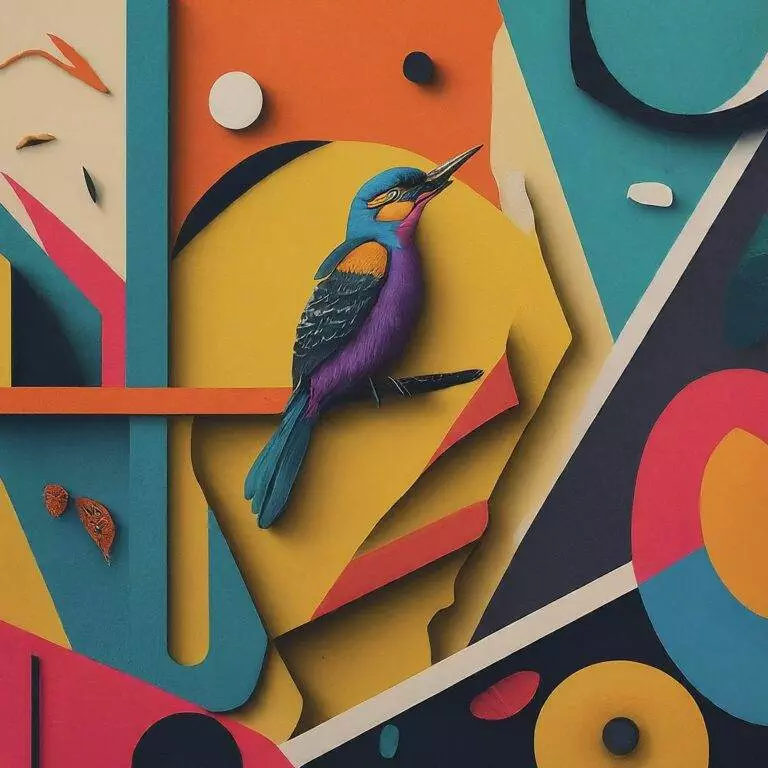What is Postmodernist Literature?
Postmodernist literature refers to a style of writing that emerged in the mid-20th century, primarily in the years following World War II. It developed as a reaction against modernism and the Enlightenment ideas of rationality, order, and absolute truth.
Table of Contents
Some of the key characteristics of postmodernist literature include:
- Fragmentation – The narrative is disjointed and lacks continuity. Postmodern novels often jump between different plotlines, time periods, perspectives, and even genres without traditional transition.
- Playfulness – Postmodernist writers subvert conventions and challenge notions of what constitutes “serious” literature. Their works incorporate irony, dark humor, parody, metafiction, and other experimental literary techniques.
- Blurring of genres – Postmodernism disregards the boundaries between genres. Works might combine elements of fiction, poetry, and even drama in unconventional ways.
- Unreliable narration – The perspective of the narrator may be purposely distorted or biased, calling into question their telling of events.
- Intertextuality – Postmodernist literature makes frequent references to other works of literature and popular culture as a self-reflexive technique. Allusions to films, songs, television, and other media are common.
The term “postmodernism” first emerged in the 1870s but did not gain widespread recognition until the post-WWII era. It arose as artists, writers, and thinkers reacted against the modernist cultural movement of the early 20th century. Modernism promoted themes of idealism, reason, and progress – tenets which were fundamentally shaken by the inhumane technological advancements and unprecedented destruction of the world wars.
Postmodernists embraced the fractured reality left in the wake of these global crises. Their literature reflects the subsequent disillusionment, skepticism, and exposure of the flaws inherent in modern society.
When Did Postmodernism Emerge in Literature?
Though the term “postmodern” first surfaced in the 1870s, postmodernism did not gain traction as a literary movement until the years following World War II. The devastation of two world wars had left many artists and thinkers deeply disillusioned with modernism and its lofty ambitions of social progress. This provided fertile ground for new ideas to take root.
Several notable events in the 1940s and 1950s helped cement postmodernism’s emergence:
- The avant-garde art exhibits in the late 1940s organized by the Museum of Modern Art in New York brought abstract expressionism and pop art into the mainstream. These styles would heavily influence postmodernist literature.
- In 1959, Donald Barthelme published his short story “The Balloon” which incorporated contemporary pop culture and influenced future postmodern fiction.
- Other seminal postmodern novels like Joseph Heller’s Catch-22 and Kurt Vonnegut’s Cat’s Cradle were published in the early 1960s.
- By the 1970s, postmodernism was widely recognized as a cohesive literary movement with the release of critically acclaimed novels like Thomas Pynchon’s The Crying of Lot 49 (1966), John Barth’s Lost in the Funhouse (1968), and Ishmael Reed’s Mumbo Jumbo (1972).
Some of the modernist authors who were forerunners to postmodernism include James Joyce, Virginia Woolf, Gertrude Stein, and Vladimir Nabokov. These writers began deconstructing traditional narrative conventions in their works during the 1920s and 1930s, paving the way for future generations of postmodernists.
In the following decades, the fractured perspectives, metafictional self-awareness, and subversion of authority that came to define postmodernism solidified it as a reaction against the formal experimentation and utopian ideals of literary modernism. By the 21st century, postmodernism had established itself at the vanguard of contemporary literature.
Characteristics of Postmodernist Literature
Postmodernist writing represents a radical break from the conventions and ideology of literary modernism. Some of the major characteristics that define the postmodernist style are:
Fragmentation and Nonlinear Narratives
- Plots are disjointed, lacking continuity and cohesion. Events do not follow traditional chronology.
- Perspectives shift unexpectedly between characters or even inanimate objects.
- Works incorporate multiple storylines and angles that intersect randomly.

Blurring of Genres
- Postmodernism disregards distinctions between fiction, poetry, drama, and essay forms.
- Works fluidly combine disparate genres into hybrid styles like prose poems or poetic fiction.
Metafiction and Self-Referentiality
- Novels disrupt the illusion of fiction through self-reflexive reminders that they are artificial constructs.
- Characters may become aware of their own fictional existence or directly address the reader/audience.
Irony and Playfulness
- Postmodernists subvert serious topics and highbrow culture using humor, exaggeration, and absurdity.
- Works incorporate parody, pastiche, dark comedy, or whimsical fantasy to undercut traditions.
Minimalism and Fragmented Prose
- Sentences use crisp, bare sentences and short paragraphs compared to modernist reverence for dense text.
- Dialogue and descriptions are terse and unembellished, often using incomplete phrases.
Notable Authors in the Postmodernism Literary Movement
Postmodernism upended conventions and challenged readers to engage with literature in radically new ways. Some of the most influential authors who propelled the postmodernist style include:
Don DeLillo
- Known for sprawling novels like White Noise, Underworld, and Libra that capture postmodern consumerist culture.
- His writing is fragmentary with multiple plot threads converging.
Thomas Pynchon
- Authored celebrated postmodern classics like The Crying of Lot 49 and Gravity’s Rainbow.
- Noted for complexity, loose structure, wide-ranging allusions, and absurdist humor.
Kurt Vonnegut
- Vonnegut’s works like Cat’s Cradle and Slaughterhouse-Five combine science fiction scenarios with dark satire.
- His disconnected anti-narratives and metafictional techniques were groundbreaking.
Vladimir Nabokov
- Nabokov’s controversial novel Lolita metafictionally draws attention to its fictional premise.
- He prodded at the thin line between fiction and reality through unreliable narration.
Margaret Atwood
- Novels like The Handmaid’s Tale contain dystopian elements while critiquing contemporary society.
- Blends genres using symbolic deconstruction and biting irony.
Salman Rushdie
- Magic realism and blending of mythological elements define works like Midnight’s Children.
- His eclectic, dreamlike narratives subvert traditional linear storytelling.
This list provides just a small sample of the writers who left an indelible mark on postmodernist literature through their pioneering use of experimental literary techniques that challenged every convention.
Examples of Important Postmodernist Novels
Postmodernist authors broke new ground by shattering traditional narrative forms. Here are some of the most important and influential postmodernist novels:
The Crying of Lot 49 by Thomas Pynchon (1966)
- A short novella epitomizing the fragmented chaos and maze-like structure of postmodern plots.
- Overflowing with cultural references and a disorientation of signs, symbols, and information.
White Noise by Don DeLillo (1985)
- Satirical depiction of 1980s consumerist culture in America and academia.
- Metafictionally self-aware, critiquing postmodern disconnect between symbols and reality.
Gravity’s Rainbow by Thomas Pynchon (1973)
- Sprawling, labyrinthine novel set in WW2 Europe that delves into paranoia, death, technology.
- Nonlinear structure weaves multiple storylines laced with conspiracy theories.
Slaughterhouse-Five by Kurt Vonnegut (1969)
- Blends science fiction with historical fiction on the firebombing of Dresden in WW2.
- Fragmented anti-narrative underscores the randomness of time and fate.
Lolita by Vladimir Nabokov (1955)
- Unreliable narrator Humbert’s disturbing memoir/fantasy about his obsession with a 12-year old girl.
- Challenges ideas of morality and fiction through metafictional angles.
The Handmaid’s Tale by Margaret Atwood (1985)
- Dystopian novel critiquing contemporary society through the lens of a near-future totalitarian regime.
- Blends genres using vivid symbolism and stark irony.
The influence of these postmodernist masterpieces continues to be felt across every genre of contemporary fiction today. Their inventive narratives still feel fresh, electrifying, and sometimes unsettling decades later.
Read This Too: Samuel Beckett and the Theatre of the Absurd: 20th Century Modernist and Postmodernist Literature
Characteristics of Postmodernist Poetry
While postmodernism is most commonly associated with novels, its influence spread across all literary genres. Postmodernist poets broke from modernism by employing many of the same techniques used by postmodern fiction writers:
Fragmentation
- Poems lack continuity and cohesion. They jump between images, concepts, voices with no transitions.
Disconnection from Reality/Non-linear
- Imagery and language usage reflects the irrational, unconscious, arbitrary and dreamlike aspects of modern life.
- Landscapes, symbols and scenes shift in surrealistic and unexpected ways, ungrounded from any concrete reality.
- There is no logical sequence of events. The poem subverts notions of time, place and story.
Intertextuality and Meta-references
- Postmodern poems make frequent intertextual references to other literary works, films, pop culture icons, current events, and more.
- They may directly reference or comment on their own composition, laying bare the mechanisms of the poem itself.
Absurdity and Unconventional Imagery
- Humor, irrational juxtapositions, and the subversion of expectations are used provocatively.
- Mundane, trivial objects take on symbolic weight and meaning. Language itself is recycled in absurd new ways.
- Everyday words and phrases are arranged experimentally to jar the reader.

Examples of Postmodern Poets
- John Ashbery, known for obscurity, indeterminate meaning, and avant-garde style.
- Frank O’Hara, prominent in the New York school of poets that incorporated contemporary culture.
- Susan Howe, inspired by deconstruction theories and fragmentary writing.
- Language poets like Charles Bernstein who focus on how reader interpretation creates meaning.
Postmodernism Compared to Modernism
While postmodernism was a direct response to modernism, the two movements share some common qualities even as they reject one another’s central tenets:
Both reject traditional literary conventions
- Modernism and postmodernism overturned the realism and rigid structures of Victorian/early 20th century literature.
- They moved away from formal plot, grammar rules, linear coherence, and moralistic themes.
Modernism focused inward; postmodernism looks outward
- Modernists were interested in the inner self and stream of consciousness.
- Postmodernists engaged with mass media, pop culture, and the interplay between symbols and society.
Differences in narrative style and perspective
- Modernists used fractured perspectives but maintained authorial voice and an element of overarching coherence.
- Postmodernists deployed more fragmented narratives with multiple voices, unreliable narration, and randomness.
While modernism preceded postmodernism, both schools of thought pushed boundaries and explored how literature constructs meaning. Postmodernism is seen as a departure from modernism’s formal experimentation into something more irreverent and unbridled.
Postmodernism in Other Creative Fields
Though most associated with literature, postmodernism grew beyond an artistic movement to permeate philosophy, art, architecture, film, and other areas. Some examples of postmodernism in other realms include:
Visual Arts
- Artists like Andy Warhol, Roy Lichtenstein, and Jasper Johns helped cement postmodern art with their focus on consumerism, mass media, and blurring of high and low culture.
- Movements like pop art, conceptual art, and deconstructivism aligned with postmodern sensibilities in their aim to subvert traditional boundaries.
Architecture
- Postmodern architects like Robert Venturi, Frank Gehry, and Michael Graves rejected rigid modernist forms in favor of eclectic, ornamental, and pop-influenced styles.
- Buildings used irony, illusion, and sculptural forms that distorted conventions.
Film
- Directors such as Jean-Luc Godard and Quentin Tarantino employed pastiche, nonlinear narratives, and self-referential metacommentary reflecting postmodern techniques.
- Genre blending, dark humor, fragmented sequencing, and intertextuality became common in postmodernist cinema.
As postmodernism’s questioning of assumed ideologies spread, its adventurous experiments with form, meaning, and cultural symbols reshaped many 20th century creative fields. It had an undeniable, if controversial, impact on broadening horizons in the arts.
Criticisms and Debates on Postmodernism
While postmodernism opened new creative doors for literature and the arts, it has been the subject of extensive debate and criticism:
Lack of originality
- Postmodernism’s reliance on pastiche, intertextuality, and recycling of older ideas can come across as unoriginal.
- Its ironic tone is sometimes seen as lacking sincerity or authenticity.
Critiques of irony and self-referentiality
- The heavy use of irony and self-reflexivity in postmodern works can seem like intellectual posturing.
- Some argue it disconnects literature from genuine emotion and the human experience.
Deliberately difficult and exclusionary
- Postmodern literature is often dense and inaccessible to the average reader.
- Its intellectual nature leads critics to argue it disregards mass audiences.
Ongoing debates on merits
- Critics assert postmodernism’s nonlinear narratives lack meaning or purpose.
- Defenders argue postmodernism accurately reflects the disorder and uncertainty of contemporary society.
- Debates continue on whether postmodernism’s subversions enrich or diminish literature.
While postmodernism made an indelible impact on contemporary literature, its experimental style and philosophical leanings remain controversial. The debates surrounding its merits are likely to persist among scholars, critics and literature enthusiasts.
Legacy and Influence of Postmodern Literature
Though its heyday has passed, postmodernism’s effect on 21st century literature remains palpable. Some of its ongoing legacy includes:
- Hybrid mixing with other genres – Contemporary authors blend postmodern techniques with other styles like realism, romance, sci-fi, and mystery. The intermixing of genres has become more common.
- Foundational for experimental literature – Postmodernism opened doors for current avant-garde and nontraditional writing by authors like David Foster Wallace, Dave Eggers, and Mark Z. Danielewski.
- Fragmented perspectives – Using multiple, disjointed narrators and perspectives first popularized by postmodernists continues to be widespread.
- Self-aware metafiction – The concept of fiction that overtly acknowledges its own artificiality and has characters address the audience directly owes its popularity to postmodern pioneers.
- Blurred lines between high and low culture – Postmodernism’s flattening of hierarchies continues to influence pop culture references and sampling appearing in literature today.
Though its revolutionary nature has dimmed, postmodernism’s irreverent spirit and inventive narrative forms left an indelible mark on how current writers approach fiction. While controversial, its legacy undoubtedly expanded literature’s creative horizons.



5 Comments
Pingback: Victorian Gothic Literature: Exploring the Dark Heart of an Era
Pingback: Agatha Christie's 'And Then There Were None': 10 Shocking Revelations - LitGram by MukeshRishit
Pingback: Witchgrass: Louise Glück's Defiant Ode to Nature's Resilience - LitGram by MukeshRishit
Pingback: The Satanic Verses by Salman Rushdie: Comprehensive Summary and Analysis - LitGram by MukeshRishit
Pingback: To Kill a Mockingbird by Harper Lee: Book Overview, Plot, Themes & More LitGram by MukeshRishit